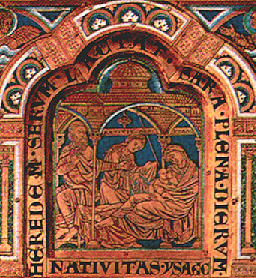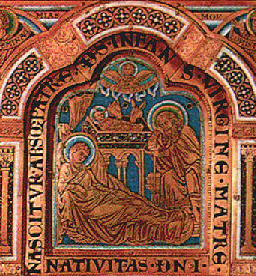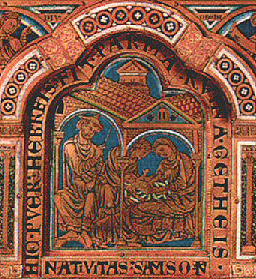

 |
|
45 panels are divided into rows of three. Those stand in connection with each other horizontally as well as vertically. The upper row shows the biblical happenings in the time before Moses, the lowest one shows the time between Moses and Christ. The middle row has pictures from the time after the birth of Christ.
Each vertical column has related motives from the three different eras. For example, one row shows a picture with Joseph in the well, the entombment of Christ and finally Jona in the belly of the whale. For all three of them it seems to be the end, but they all experienced some form of "resurrection". Another row shows the rapture of Enoch, Christ's Ascension and the ascension of Elijah. Just making the concept of this work is a marvellous initiative ... The guilded panels stand out from the blue background of enamel and are labeled in black, with Latin text.
Until 1330 the altar decorated the pulpit. On September 13th of that year, there happened a catastrophy. The city of Klosterneuburg became victim of a big fire, which didn't spare the monastery either.
The legend tells, that when the rescuing party ran out of water, the pulpit was poured over with the wine, that the monastery produced, and that it was possible to save the magnificent piece of art in that way.
Provost Stephan von Sierndorf let rebuild the monastery and from a Viennese workshop he required two new vertical rows (today 8 and 10), so that the casing of the pulpit now could be used as winged altarpiece. Until 1833 the altar had its place in the church of the monastery, but was moved into the hidden cellar departsments, where it can be seen only on a guided tour. On top of the altar there is an urn, consisting the bones of Leopold III, the founder of the monastery.
© Bernhard Kauntz, Wolvertem, Belgium 2013
|







